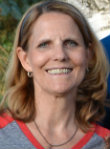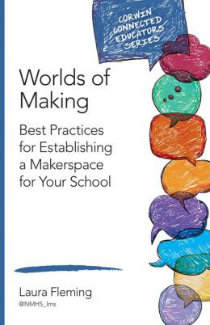Want to Create a Makerspace? Here’s How
Worlds of Making: Best Practices for Establishing a Makerspace in Your School
By Laura Fleming
(Corwin, 2015 – Learn more)

“Schools are turning to makerspaces to facilitate activities that inspire confidence in young learners, and help them acquire entrepreneurial skills that are immediately applicable in the real world.” So the recent NMC Horizon Report 2015 describes one purpose of makerspaces.
Laura Fleming, author of Worlds of Making – Best Practices for Establishing a Makerspace for Your School offers an overview of the maker movement with guidelines for creating your own.

The book is a short read (65 pages) organized around the essential pieces for a Makerspace:
- The Maker Movement
- Planning Your Makerspace
- Setting Up Your Makerspace
- Creating a Maker Culture in Your School
- Makerspaces and the Standards
- The “Expert” Maker
- Makerspaces and the School Library
- Makerspaces as a Unique Learning Environment
- Showcasing Student Creations
Each chapter covers the basics of beginning a Makerspace. The author centers the plan of a Makerspace around several key ideas. First, it is important to understand your school community and how the Makerspace will fit into the present curricula, programs and offerings. Next, consider global trends and best practices.
After the initial planning, develop a theme and match the equipment and materials. I especially appreciated the encouragement when Fleming stated, “It is not necessary to be a technical expert to start a makerspace in your school or library.”
Practicalities and student involvement
The kinds of practical considerations highlighted in the book include electrical outlets, a strong WiFi network, and sinks. Input from students is essential in the design. “The learner-focus of a makerspace must be more than mere rhetoric or sloganizing; it is absolutely critical to take into account the interests of those for whom the makerspace is primarily created.”
The layout suggested includes both “flexible” and “fixed” stations. Fixed stations included a Little-Bits Bar, a Lego table, a Makey-Makey station, and a 3-D Design and Printing station. Flexible stations included activities relating to robotics and electric circuitry.
The culture of your school is critical in developing a makerspace. “Students (must) have a right to tinker, create, innovate, make, and do.” Risk taking is also encouraged by both the teacher and the student. Personally, this challenges me to move out of my comfort zone and experiment in areas that I am not the expert. Why? How can I expect students to take risks if I’m not modeling that behavior for them?
In the remainder of the book, the author connects standards, includes information about expert makers, talks about expanding libraries as makerspaces, and showcases student projects. This is a concise, short guide, covering the spectrum in the planning and development of a makerspace.
Ideas in the book sparked new ideas for our school. They also created more questions about the progress of our makerspace. All good. Isn’t question-making and answering the principle behind a makerspace?
_____________
Sandy Wisneski (@stampcat2) is a lead teacher at Catalyst Charter Middle School in Ripon, WI. She is the district Webmaster, tech mentor, yearbook advisor as well as new teacher mentor. Over the past 40 years, she has become certified as a Flat Classroom Teacher and obtained her masters in reading. She is also a Graphite Certified Teacher. The summer of 2014 she attended Honeywell Educators @ Space Academy. She enjoys challenging students to “take ownership” for their learning and to be effective digital citizens in the world.


































